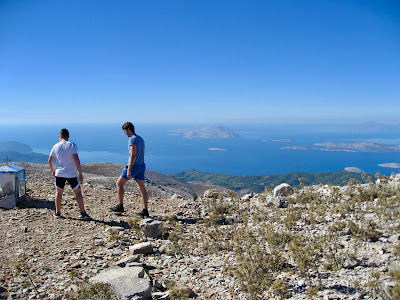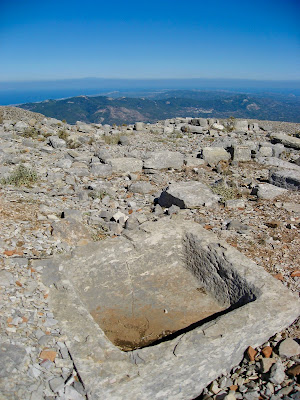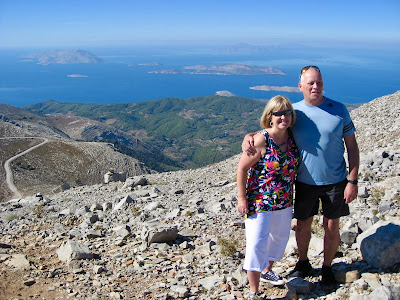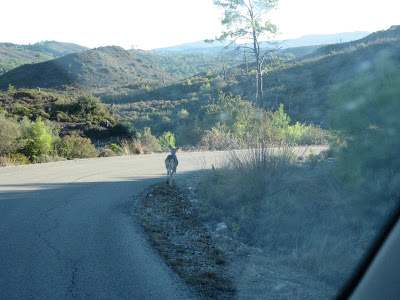Well, the temperatures are almost imperceptibly dropping little by little and the birds in the garden becoming more diverse again as the cooler months of the winter approach, and it is good. We've already been delighted by robins, jays and redstarts, even blue tits and warblers, making use of our two 'bird baths,' which are simply two plant pot trays placed on the ground in different parts of the garden. Oh, and we now have resident blackbirds too, which we're very excited about, because it's only in the past couple of years that they've started taking up residence in the garden and orchard.
We've had some rain, although still not as much as we ought to, but it's meant we can turn off the irrigation system for a while and let nature do the job instead. I know it's been said so often, but real rain is so much better for the garden than water from the tap.
What I really love about this time of the year is the fruit trees and how they look...
We often remark on the fact that, if you plan your cuisine to fit in with the rhythm of the seasons, you soon find that the earth produces what you need at the right time. Here we are, heading into another winter, which, granted, is not much of a winter weather-wise by northern European standards, but nevertheless the nights can be chilly and you can get caught out in the rain (hopefully!) now and then in daylight, and the produce of the season is citrus fruit, crammed with vitamin C.
It's amusing too, to see that, despite the fact that the daytime temperatures lately have been consistently in the twenties Celsius, if you go an sit in a café in your shirtsleeves, perhaps even still a long pair of tailored shorts, you'll be surrounded by Greeks in jeans, boots, woolly socks, jumpers, scarves and leather jackets.
Most of our Greek friends aren't harvesting their olives this year. As you probably already know, olive trees tend to produce abundantly on a two-year cycle, but this year's harvest has been affected by the distinct lack of rainfall during October and November anyway. When I say 'lack', I mean in comparison to what's needed. Once you get into October, the locals are to be seen turning over the soil around their olive trees, so as to let the hoped-for rain penetrate below the surface and reach the roots. This, normally, enables the olives to fatten up during the last month-to-six weeks prior to being harvested, but this year the rains just haven't been enough around these parts.
Night-time temperatures are now beginning to drop to winter levels. Tonight, for instance, as I type this at around 2.00am, it's 12ºC outside. It doesn't get much colder than that as a norm throughout most of the winter, except when we get the occasional 'cold snap' that during most winters might occur two or three times.
We've already been out scouring the surrounding area for wood for the stove. We've come up trumps too, as it happens. Within walking distance of the house there are several dead trees that we shall be able to cut and bring home. In fact we've already had our first foray and returned with some four-foot-long lengths that we were able to section down to stove-size using my newly-built saw horse. Most gratifying. of course, cutting any live tree, or part thereof, is strictly illegal as is the culling of dead ones too if you're thinking about selling the wood. That's a 'no-no.'
We usually light our wood-burner around the end of the first week of December. Looks like it's going to be near enough on schedule this year. Then we'll be using it most evenings until the beginning of March. We actually have lit it once already, about a week ago, but the evening temperatures since then have again been too warm to warrant it.
Finally, out in the garden a couple of days ago, we were gardening in bright sunshine, when just a few kilometres up in the hills above us and to our north, the sky was as black as your hat and rain could be seen sheeting down, probably around the Siana, Embona district. We didn't get the rain, but we did get a double rainbow. I did whack one photo on Facebook, but here are all three that I took then. I'm only sorry that one of the rainbows had almost vanished by the time I was able to get the camera out and take the shots...
Anyway, 'tis the season to be saying to all and sundry "Kalo himona!"
Funny how small things can get one so excited, like being able to wear your jeans again and go for long walks without dissolving into a morass of sweatiness. Winter's here and I say, bring it on.
We've had some rain, although still not as much as we ought to, but it's meant we can turn off the irrigation system for a while and let nature do the job instead. I know it's been said so often, but real rain is so much better for the garden than water from the tap.
What I really love about this time of the year is the fruit trees and how they look...
 |
| Grapefruit packing the tree, with many more 'lurking' in the inner branches than at first meets the eye. |
 |
| A little lemon tree that we almost gave up for dead a couple of years ago. Now it's crammed full of lemons, which are just beginning to turn from green to yellow. |
We often remark on the fact that, if you plan your cuisine to fit in with the rhythm of the seasons, you soon find that the earth produces what you need at the right time. Here we are, heading into another winter, which, granted, is not much of a winter weather-wise by northern European standards, but nevertheless the nights can be chilly and you can get caught out in the rain (hopefully!) now and then in daylight, and the produce of the season is citrus fruit, crammed with vitamin C.
It's amusing too, to see that, despite the fact that the daytime temperatures lately have been consistently in the twenties Celsius, if you go an sit in a café in your shirtsleeves, perhaps even still a long pair of tailored shorts, you'll be surrounded by Greeks in jeans, boots, woolly socks, jumpers, scarves and leather jackets.
Most of our Greek friends aren't harvesting their olives this year. As you probably already know, olive trees tend to produce abundantly on a two-year cycle, but this year's harvest has been affected by the distinct lack of rainfall during October and November anyway. When I say 'lack', I mean in comparison to what's needed. Once you get into October, the locals are to be seen turning over the soil around their olive trees, so as to let the hoped-for rain penetrate below the surface and reach the roots. This, normally, enables the olives to fatten up during the last month-to-six weeks prior to being harvested, but this year the rains just haven't been enough around these parts.
Night-time temperatures are now beginning to drop to winter levels. Tonight, for instance, as I type this at around 2.00am, it's 12ºC outside. It doesn't get much colder than that as a norm throughout most of the winter, except when we get the occasional 'cold snap' that during most winters might occur two or three times.
We've already been out scouring the surrounding area for wood for the stove. We've come up trumps too, as it happens. Within walking distance of the house there are several dead trees that we shall be able to cut and bring home. In fact we've already had our first foray and returned with some four-foot-long lengths that we were able to section down to stove-size using my newly-built saw horse. Most gratifying. of course, cutting any live tree, or part thereof, is strictly illegal as is the culling of dead ones too if you're thinking about selling the wood. That's a 'no-no.'
We usually light our wood-burner around the end of the first week of December. Looks like it's going to be near enough on schedule this year. Then we'll be using it most evenings until the beginning of March. We actually have lit it once already, about a week ago, but the evening temperatures since then have again been too warm to warrant it.
Finally, out in the garden a couple of days ago, we were gardening in bright sunshine, when just a few kilometres up in the hills above us and to our north, the sky was as black as your hat and rain could be seen sheeting down, probably around the Siana, Embona district. We didn't get the rain, but we did get a double rainbow. I did whack one photo on Facebook, but here are all three that I took then. I'm only sorry that one of the rainbows had almost vanished by the time I was able to get the camera out and take the shots...
Anyway, 'tis the season to be saying to all and sundry "Kalo himona!"
Funny how small things can get one so excited, like being able to wear your jeans again and go for long walks without dissolving into a morass of sweatiness. Winter's here and I say, bring it on.



















































